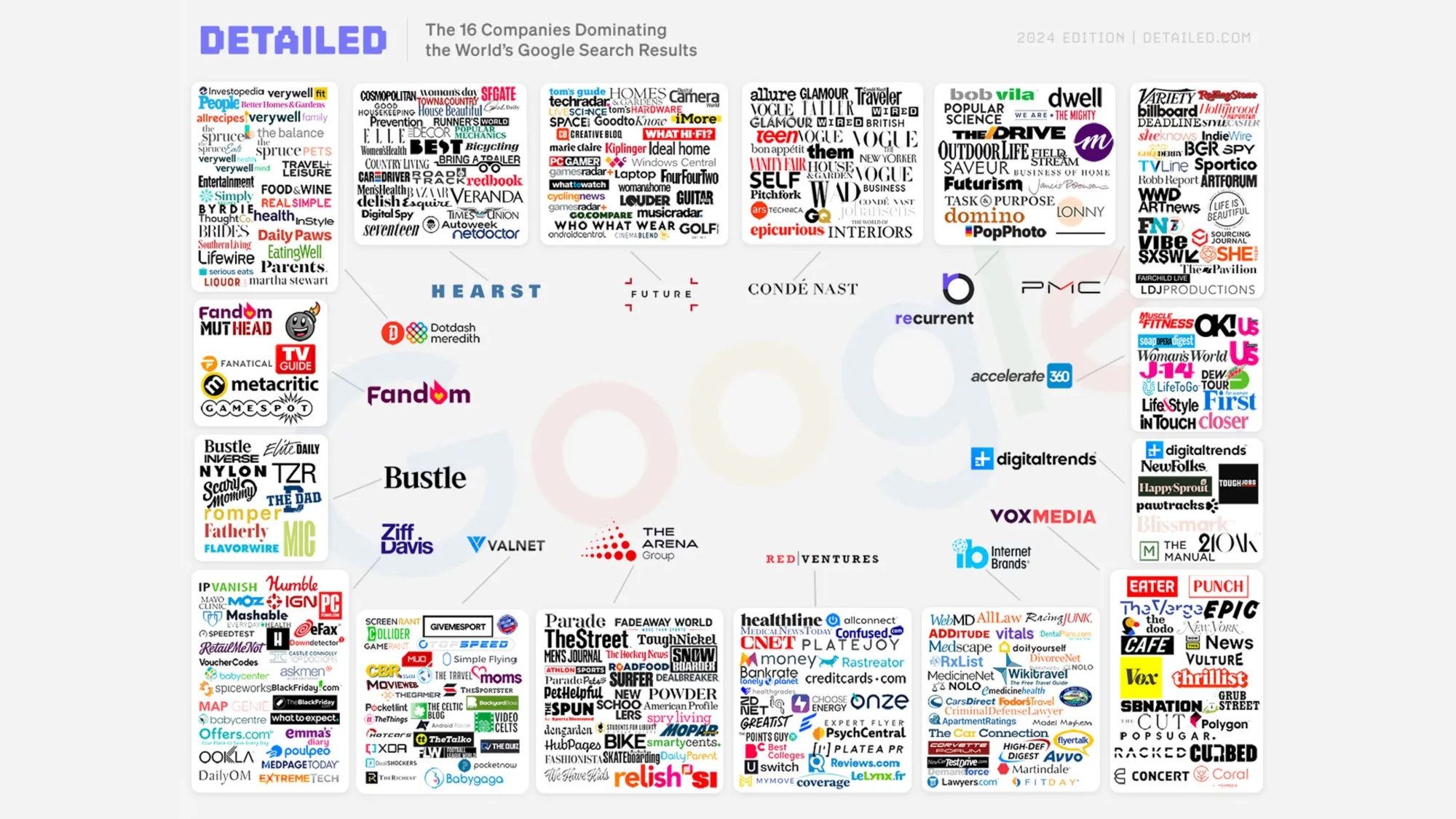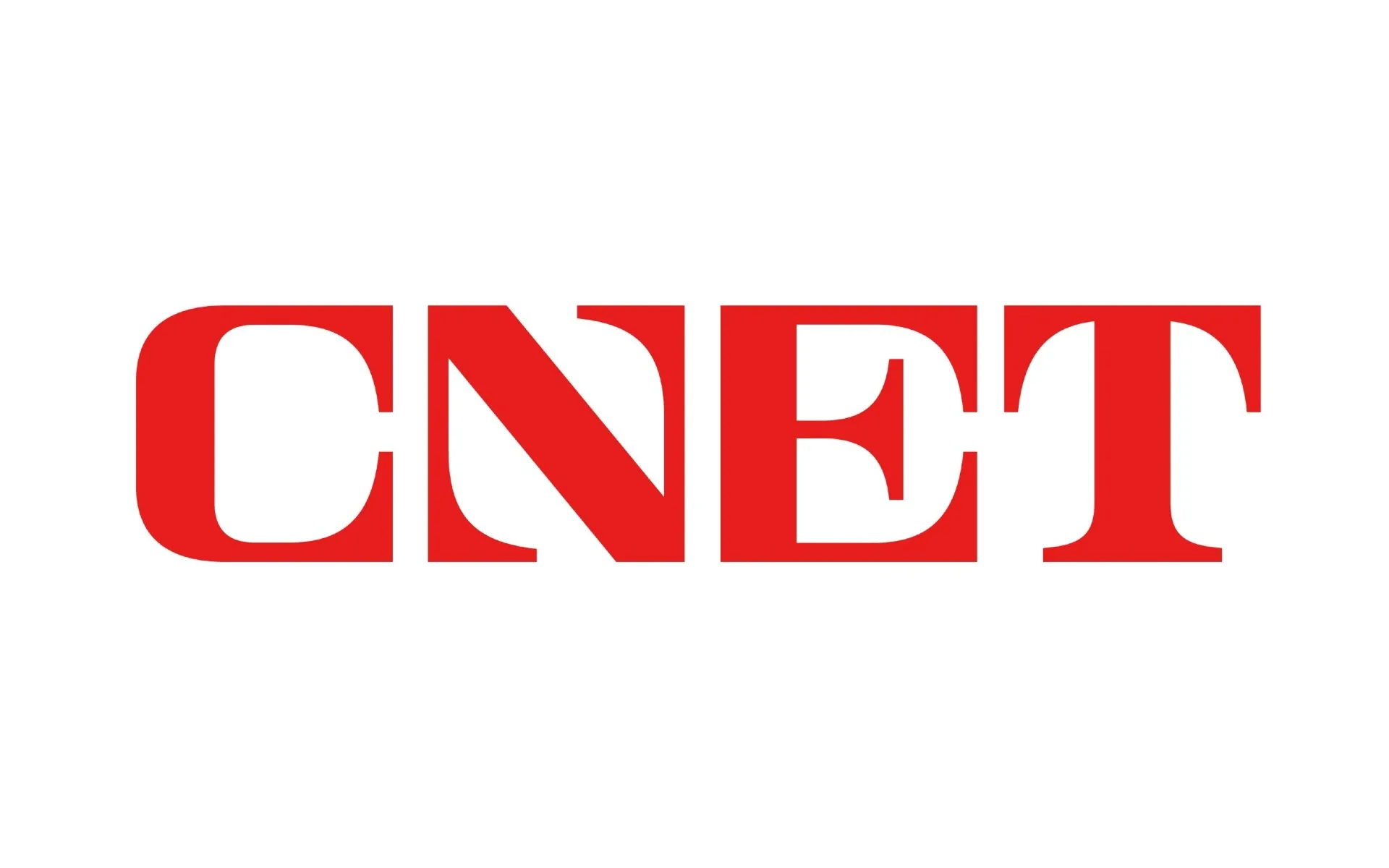Google search monopoly: 16 media companies control what you see
How a small group of digital goliaths dominate search results as Google restricts publisher customization.

According to detailed analysis released in 2024, just 16 media companies control the vast majority of content appearing in Google's search results. This finding raises serious concerns about market concentration and the future of independent publishing, especially as Google continues to implement changes that further restrict publisher control.
Get the PPC Land newsletter ✉️ for more like this
Research conducted by Glen Allsopp reveals that 16 media conglomerates effectively control what most users see when searching on Google. These companies, which include Dotdash Meredith, Hearst, Future, and Condé Nast, collectively own at least 588 individual brands that appear prominently across search results.
The report, published in 2024, represents a comprehensive investigation into search result ownership to date. It meticulously tracks ownership patterns across multiple industries and search categories.
"Combined, Semrush estimates they pick up around 3.5 billion clicks from Google each month. An average of 5.9 million monthly clicks per site," Allsopp notes in his findings, underscoring the massive traffic advantage these companies enjoy.
The dominance is particularly evident in product-focused searches. Across 10,000 terms where affiliates typically rank well, these 16 companies appeared on the first page for 85% of the queries examined. Even more concerning, in 1,584 of these search results, they claimed four or more of the top 10 organic positions.
Yes - that's one problem with cartels: pretty much anyone who works in the digital publishing space will have a client on that graphic
— Nate Hake (@natejhake) April 21, 2025
I am generally in favor of publisher unity against Google, so it's challenging to make this point as it does tend to divide a group we want…
Among the dominant players, Dotdash Meredith emerges as particularly powerful, with websites appearing in 6,788 search results across the sample. Hearst follows with presence in 5,144 search results, while Future (4,408) and Condé Nast (3,734) round out the top four.
Specific brands under these conglomerates capture enormous search visibility. For example, Fandom.com (owned by Fandom/IMC) receives an estimated 606.2 million monthly search visits, while MayoClinic (Ziff Davis) captures 342 million. In the health sector, Red Ventures' properties Healthline and MedicalNewsToday collectively receive over 310 million monthly visits from search.
These companies have achieved their dominant positions through aggressive acquisition strategies, purchasing established websites and leveraging their existing domain authority to rapidly launch new properties. The research documents how they build interconnected networks of sites that reinforce each other's authority in Google's ranking system.
Market concentration across industries
The concentration extends across virtually every major content category. The analysis reveals:
- Arts & Entertainment: 62 controlled sites
- Health: 61 sites
- Computers & Technology: 61 sites
- News & Media: 60 sites
- Sports: 59 sites
- Lifestyle: 42 sites
- Home & Garden: 35 sites
This concentration means consumers often encounter the same corporate perspectives, despite an appearance of variety in search results. For instance, when searching for product reviews, users might see multiple apparently different websites, not realizing they're owned by the same parent company.
The financial implications are substantial. Ziff Davis, one of the 16 dominant companies, reported digital media revenue of $1 billion for 2023. Future generated £788.9 million that same year, while Dotdash Meredith reported $892.5 million in digital revenue. For many of these companies, affiliate marketing revenue—driving consumers to make purchases through their reviews—represents a substantial and growing portion of their business model.

Strategies for dominance
The research identifies several key tactics these media conglomerates employ to maintain their search prominence:
- Cross-promotion through footer links: Companies place links to their other properties in site footers, effectively distributing authority across their network.
- Rapid deployment of new sites: Leveraging existing domain authority, these companies can launch new properties that rank almost immediately for competitive terms.
- Content sharing across properties: The same content frequently appears on multiple owned sites, maximizing exposure and revenue potential.
- Strategic acquisitions: Companies routinely purchase successful independent sites in valuable niches, further consolidating their market power.
- Keyword targeting optimization: Their considerable resources allow for sophisticated keyword research and targeting strategies beyond what smaller publishers can implement.
Get the PPC Land newsletter ✉️ for more like this
Impact on the digital ecosystem
This market concentration raises significant concerns for both consumers and independent publishers. For consumers, the illusion of choice masks a reality where the same corporate entities control much of the information they encounter. Product reviews, health information, and news increasingly come from a handful of corporate sources with similar business models and incentives.
For independent publishers and content creators, the landscape has become increasingly challenging. Breaking into competitive search categories now means competing against massive corporate networks with enormous resources and existing authority.
"I'm primarily focused on networks with sites in a variety of niches (such as Pets, Tech, Food and Sports) that typically publish English-language content," explains Allsopp. "Many are incredibly financially successful, in no small part due to the traffic search engines like Google send their way."
Google restricts publisher control while concentration grows
The concentration of search visibility raises important questions about the future of information discovery online. While Google has previously implemented algorithm updates aimed at promoting content diversity and quality, these efforts have not prevented the current oligopoly from forming. Recent developments suggest this trend may accelerate further.
According to a February 10, 2025 announcement, Google News completed its transition to automatically generated publication pages in March 2025. This significant change eliminated manually created publication pages in favor of an automated system. Publication pages previously created by publishers through the Publisher Center are no longer visible to Google News users, and the Publisher Center has discontinued customization features.
Under this new system, publishers can no longer manually customize how their logos and publication titles appear in Google News. Instead, the system automatically uses site favicons for publisher logos and site names for publication titles, creating a unified visual appearance across Google's news surfaces. Google frames these changes as workflow improvements, but they effectively reduce publisher control over their brand presentation.
For smaller publishers already struggling against the dominance of media conglomerates, these changes create additional technical hurdles. While some niche categories remain less dominated by major players—such as fishing, motorcycling, board games, and hiking—the general trend toward concentration continues, with the largest media companies continually expanding their digital portfolios.
This pattern mirrors broader consolidation trends seen in traditional media sectors like newspapers, radio, and television over recent decades. For marketers and businesses operating online, these developments underscore the importance of understanding the actual competitive landscape while adapting to Google's increasingly automated content organization systems.
Timeline of search dominance and Google's increasing automation
- 2016: Glen Allsopp first documents the beginning of this trend, identifying early patterns of media consolidation in search results.
- 2022: Digital Trends Media Group shares seven updates about their business in their "Press Room," later becoming quiet about operations.
- 2023: Dotdash Meredith reveals their 19 core brands, which drive 80% of their website traffic and receive almost all of their content and technology investments.
- 2023-2024: Future announces plans to invest an additional £8M in news, reviews, and shopping guides, adding 150 people to their editorial team.
- April 2024: Google announces a major update to Google News, beginning the transition to automatically generated publication pages.
- February 10, 2025: Google announces the final phase of eliminating manual customization for publisher pages, to be completed in March 2025.
- March 2025: Google News completes transition to automated systems for publisher pages, removing manual customization options and further reducing publisher control over their presentation.
- April 21, 2025: Additional reports emerge about Google's changes to ad placement in search results and the ongoing antitrust battle with the Department of Justice over "sweeping remedies."
As search engines and social media platforms continue to serve as primary information gateways, the twin challenges of media concentration and decreasing publisher control over content presentation create significant concerns for information diversity, market competition, and the health of the digital publishing ecosystem. With Google's latest changes following so closely after confirmation of the market dominance by a handful of media companies, the rules of digital publishing continue to shift in ways that may further consolidate power in fewer hands.


